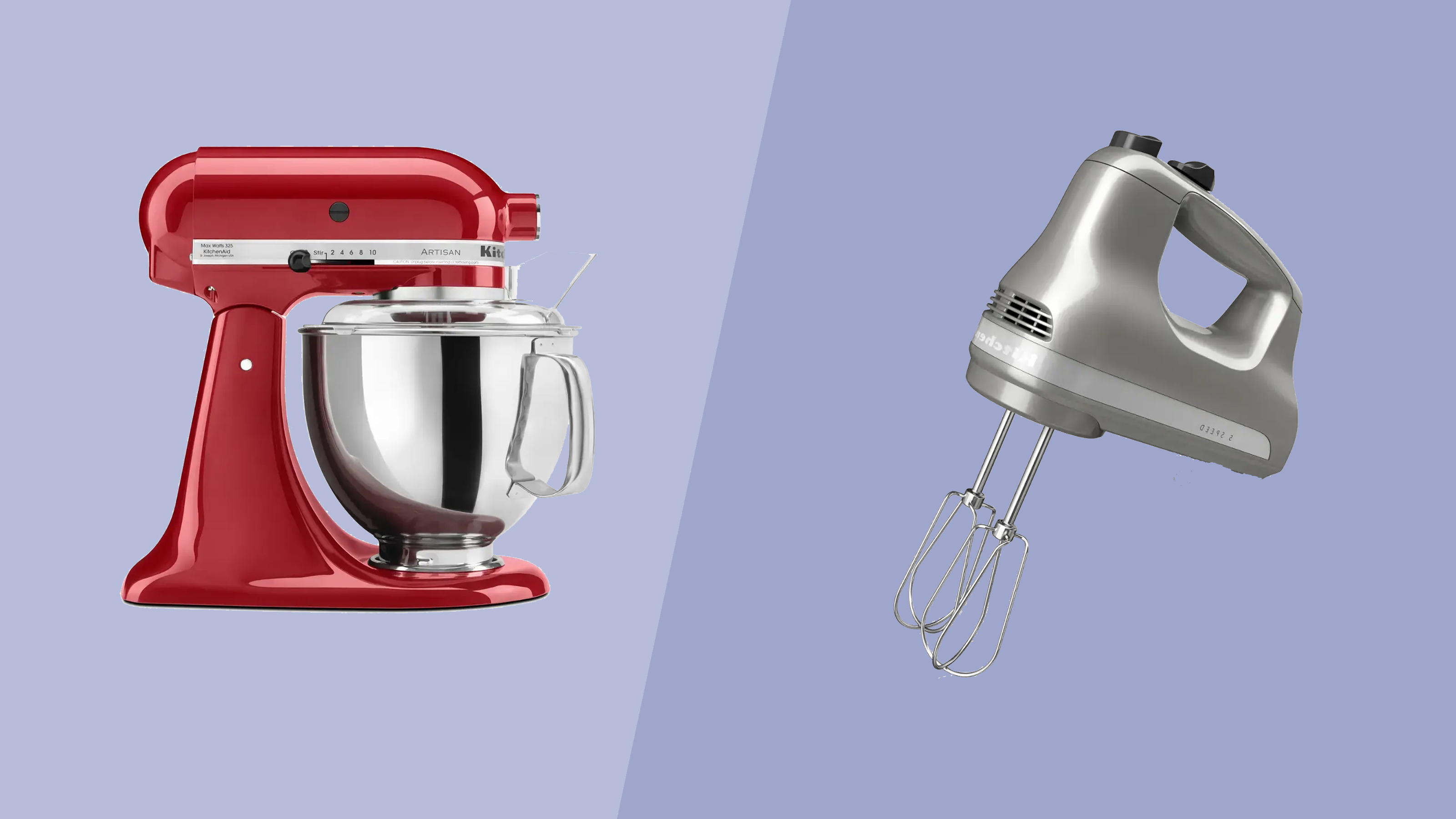When it comes to home baking, choosing the best food mixer doesn’t just come down to price or looks – it’s about finding one that meets your needs without overwhelming you with features you won't use.
Hand mixers and stand mixers are the two most popular options for whipping up a quick batch of cookies or tackling a multi-layered celebration cake.
Hand mixers are best known for being affordable and portable, making them ideal for quick, light tasks that don’t require heavy-duty power. Stand mixers are renowned for their versatility and power, which makes them better for tackling larger bakes or more complex recipes. That doesn't mean stand mixers automatically replace hand mixers, though, or that hand mixers don't offer a range of benefits.
This guide compares the benefits and limitations of both mixers, comparing their key features, performance, and price points to help you decide which is best for you. It also features expert insights from Marcus Lux, Head of Gastroback, UK Export & Business Development, Charles Cadman, Product Developer for Salter, and Lee Daly and James Payne, Senior Product Managers at Kenwood Cooking and Baking.
Hand mixer vs stand mixer: Price & value
Prices for hand and stand mixers vary due to their differences in design, functionality, and the type of people they're targeted at.
"Hand mixers are a great first step into making your baking experience more enjoyable while being able to make larger and more complex recipes," says Payne.
Basic models provide enough power for light tasks, such as mixing cake batter or whipping cream, for as little as $10-$15, including the Elite Gourmet EHM003M. Hand mixers offering a more balanced mix of advanced features and robust design will set up closer to $30-$60.
The $29.99 Hamilton Beach 6-Speed Electric Hand Mixer comes with a whisk, dough hook, and beater attachment. Alternatively, the KitchenAid 5 Ultra Power Speed Hand Mixer, which is twice the price, only comes with one beater choice but has a more powerful motor, easy-to-clean whisks, and 11 colors.
It is possible to spend as much as $150 on hand mixers such as the KitchenAid KHM926. For the extra money, you get not only nine speeds but also added power and robust beaters, which means it can handle thicker mixes or larger chunks of food.
On the other hand, stand mixers are designed for heavier-duty use and come with mixing bowls and more powerful motors as standard.
Entry-level stand mixers retail for between $50-$70. This end of the market is dominated by Hamilton Beach, with models like its Classic Stand Mixer ($49.99) and Better Chef's 3.5Qt range ($54.99)
Due to their more complex build and functionality, higher-end stand mixers, including those in the KitchenAid Artisan range, cost between $350 for mini and 3.5-quart models and $500 for the Artisan Series 5. Spending more than $500 puts you in the realm of professional-use mixers that are closer to food processors and offer much more than just mixing.
For example, the $629.99 Kenwood Chef Kitchen Machine has a 7Qt bowl and can be used as a pasta cutter, meat grinder, ice cream maker, and more, depending on the attachment used. Meanwhile, the $1,485 Kenwood KWL90.004S has a digital display and built-in scales to warrant the higher price.
Although stand mixers have a higher upfront cost, they often represent better value due to their versatility and durability, especially for avid bakers. Hand mixers, however, are a much better choice for occasional bakers looking for a simple, cost-effective option—people who don't want all the bells and whistles of a stand mixer or don't have the space for one.

Hand mixer vs stand mixer: Features & functions
Both hand and stand mixers are used for the same general jobs—whisking, beating, creaming, and mixing—but their respective sizes and features make them better suited to different tasks within these jobs.
The features of hand mixers are designed for simplicity and convenience. They typically come with basic speed settings, between three and nine, and let users adjust the power levels using simple dials or switches. Many models include a turbo mode, which uses short bursts of extra power for tougher mixing jobs. Although the motors on hand mixers are less powerful than stand mixers, this also makes them quieter.
Attachments for hand mixers are similarly straightforward and include essentials like beaters for mixing and whisks for whipping. Higher-end models might include dough hooks for light kneading tasks, but they're generally not designed for heavy-duty dough work.
Some hand mixers, such as the KitchenAid 9-Speed Hand Mixer, can also feature soft-start technology. This helps prevent the ingredients from splattering everywhere when you start mixing, especially at higher speeds. Other advanced models are battery-operated, including the Cuisinart EvolutionX Cordless Hand Mixer, offering the freedom to mix without being near a power outlet.
Stand mixers, on the other hand, offer more advanced features.
"Stand mixers are larger units with a built-in mixing bowl, ideal for large batches and heavy-duty tasks, such as kneading dough, said Cadman. "While taking up more kitchen space and requiring a higher investment, they're designed for frequent bakers with extensive mixing needs."
Their motors are significantly more powerful, allowing them to handle heavy-duty tasks like kneading a lot of bread dough or mixing double batches of batter.
Another standout feature of stand mixers is their so-called "planetary" mixing action. This means their attachment rotates in one direction, while the head rotates in the other to combine the ingredients in their dedicated bowls better. These stand mixer bowls are then made of stainless steel or glass. Many models also feature tilt-head or bowl-lift designs, which gives you easy access to the bowl and attachments.
Beyond basic attachments like whisks, dough hooks, and flat beaters, stand mixers often offer other accessories like pasta rollers, meat grinders, spiralizers, and even ice-cream makers, such as the Kenwood Chef Kitchen Machine.

James Payne has more than six years' experience managing global product strategies for Kenwood's mid- and high-price kitchen machines, including the kMix range.

Hand mixer vs stand mixer: Performance
Hand mixers perform particularly well for smaller, precision tasks.
"Hand mixers are often a baker's first introduction to powered mixing and are perfect for light and quick tasks, such as smaller batches of cake mix, Yorkshire pudding batter, or pancakes," says Daly.
Their smaller motors, typically 150W to 300W, provide enough power for everyday tasks without being overly noisy or cumbersome. A good hand mixer will offer consistent speed control, allowing you to add ingredients or ramp up the power as needed gently.
However, hand mixers' performance can drop when tackling heavier or thicker mixtures or more complex tasks. Attempting to knead dough or mix stiff batters with a hand mixer, especially one that doesn't have a dedicated dough hook or similar, can result in overheating, uneven results, or strain on the motor.
Stand mixers are instead built for power and durability. Their motors, which often range from 300W to over 1000W, are more robust, and this power not only means they can better knead stiff dough or large quantities of batter for layer cakes, but they do so with more consistent speed and torque. "Some XL stand mixers can whisk up to 16 egg whites, 3.1kg of an enriched bread dough, and 4kg of an all-in-one cake mixture," explains Daly.
Using planetary mixing also helps eliminate pockets of unmixed ingredients and reduces the need to scrape mixtures down the sides of the bowl. Both of these help improve the texture and evenness of your food.
According to Lux, stand mixers are better for multitasking than hand mixers. "Stand mixers are fixed in place and are good for lots of batch mixing as you don't have to hold them in place like a hand mixer." This hands-free operation means you can prepare other ingredients or clean up while the mixer does its job.

Charles is product developer at Salter. Salter is a kitchenware brand that sells a wide range of leading appliances from mixers to coffee machines, scales, and frying pans. Salter has been making kitchenware since 1760.

Hand mixer vs stand mixer: Which is best?
Choosing between a hand and a stand mixer depends on your needs and baking habits/skills.
A hand mixer is better for light tasks like whipping cream, beating eggs, or mixing cake batter. It’s portable, affordable, and easy to store, making it ideal for casual bakers or people with limited space.
A stand mixer is better for frequent bakers or anyone who tackles more complex recipes, such as kneading bread dough, meringues, or preparing large batches of batter. Stand mixers are more powerful, versatile, and easily handle heavy-duty tasks.
If budget and space allow, a stand mixer is a long-term investment for serious bakers, but a hand mixer can do much of what a stand mixer does for a lower price.

Marcus Lux is Head of UK, Export & Business Development at premium household electricals manufacturer Gastroback. With over 30 years’ experience selling quality products around the world, Gastroback’s aspiration is to set trends focused around design, high quality materials, professional performance and safety.
Hand mixer vs stand mixer: what the experts say
Lux believes that stand mixers have seen an explosion of interest in recent years thanks to high-profile baking shows, making them as much of a "style statement" as a functional kitchen gadget, adding that this is great if you have the countertop space. However, suppose you don't have the space. In that case, Lux is still an advocate of hand mixers – especially when you add attachments such as high-speed grinders or similar – because they still offer great versatility while being good value for money.
Daly even believes there's room for both in your kitchen. "You can do all the tasks of a hand mixer with a stand mixer and more. However, many people who have owned a hand mixer first see the benefits of dual ownership. They use their hand mixer for quick and simple recipes as it is quick to set up and clean, before using their stand mixer when they need more power, larger quantities, or longer duration mixes."

Lee Daly has more than six years' experience at Kenwood, managing new product development for appliances like the Kenwood Chef, Prospero Plus, and Hand Mixer portfolio, including the recent launch of the Kenwood Go collection.
Hand mixer vs stand mixer: FAQs
Can you make pastry in a stand mixer?
Stand mixers are particularly good at handling tasks like rubbing butter into flour for shortcrust pastry or mixing dough for puff pastry. Using a paddle attachment, a stand mixer can cut the butter into the flour evenly without overworking the dough, which is key for getting a flaky texture.
However, it’s important to note that stand mixers may not have the same precision as an electric or even manual hand mixer, and you need to be careful not to overmix.
What are the disadvantages of a stand mixer?
Despite their advantages, stand mixers do have some drawbacks.
They're more expensive than hand mixers, and their size can be a challenge for smaller kitchens or those with limited counter or storage space.
They're less portable and not as convenient for small, quick tasks, and cleaning can take longer, especially if your attachments and bowls aren’t dishwasher-safe.
Finally, the power of a stand mixer may not be best for the lightest of tasks, and you could quickly ruin a mixture without realizing it.
What are the disadvantages of a hand mixer?
Hand mixers, while affordable and convenient, have several limitations, too.
They often lack the power and stability to handle heavy-duty tasks like kneading bread dough or mixing thick batters. You have to manually hold them throughout the process, which can be tiring during longer sessions.
Hand mixers also have smaller attachments and limited capacities, making them less suitable for large batches.
A hand mixer may feel underpowered and less efficient for complex recipes or regular baking compared to a stand mixer.

